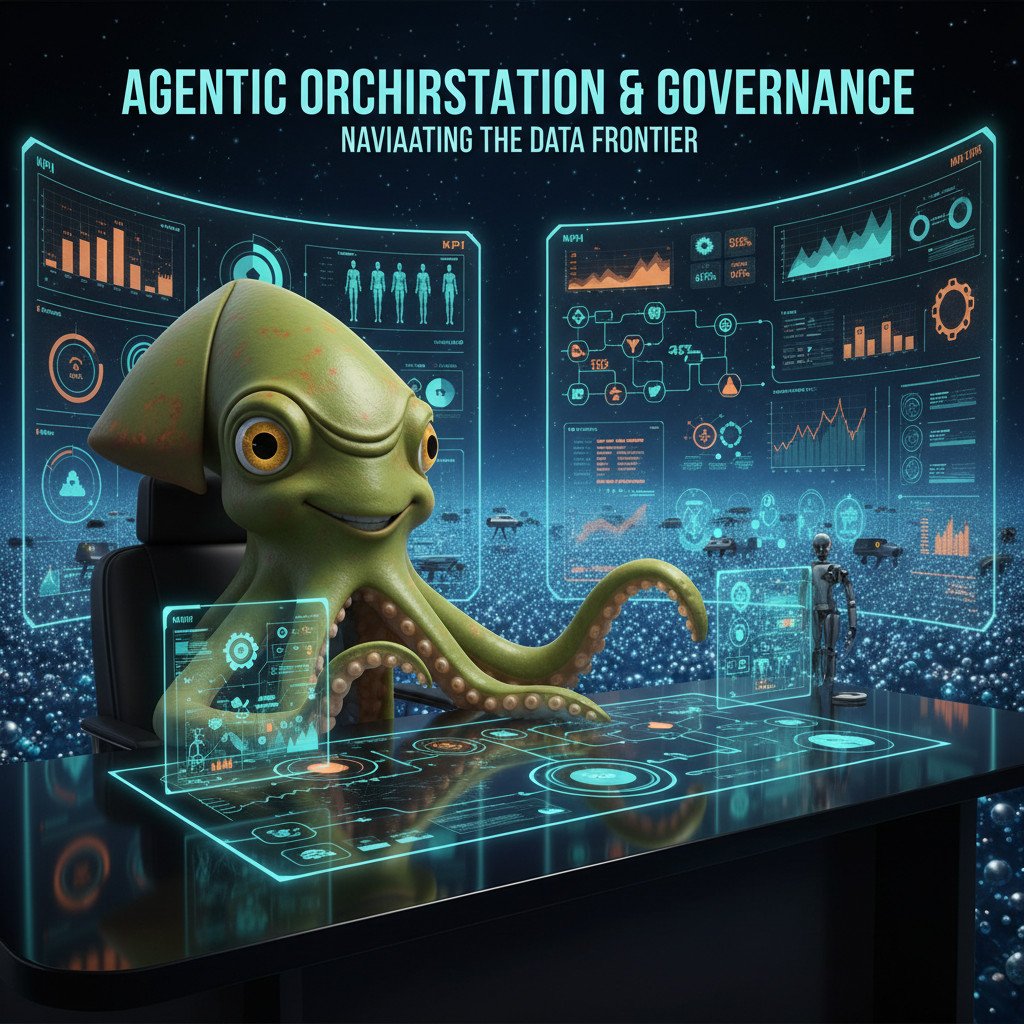Agentic AI Orchestration and Vibe Analytics in the Enterprise
Agentic AI orchestration and vibe analytics in the enterprise are reshaping how organizations run operations, make decisions, and scale outcomes. These technologies combine autonomous agents with sentiment aware analytics to drive faster, context rich action. Meanwhile, they let nontechnical teams query operational data in plain language, while sophisticated agents execute and report results. As a result, enterprises can cut cycle times and reduce human error.
However, the promise depends on clean data, strong governance, and reliable orchestration patterns. For example, poorly integrated data pipelines create brittle agents and misleading vibe signals. By contrast, robust data plumbing and guardrails create explainable, auditable automation. Moreover, semi technical users benefit when platforms hide code but expose transparent logic.
This article outlines readiness steps across automation, data, and adoption. It covers practical tactics such as data normalization, KPI dashboards, natural language queries, and rollout playbooks. Consequently, teams can deploy agentic automation safely and unlock real time, actionable insights. Read on to discover strategic patterns, governance guardrails, and adoption best practices for enterprise scale.

Agentic AI orchestration and vibe analytics in the enterprise
Agentic AI orchestration coordinates autonomous agents, data flows, and business rules to run tasks end to end. It sits above point automation and manages intelligent workflows, decision logic, and escalation paths. By combining AI orchestration with vibe analytics, enterprises transform raw signals into actionable work. Moreover, this pattern turns natural language intent into automated outcomes.
How Agentic AI orchestrates decisions and automation
At its core, AI orchestration links connectors, APIs, and data pipelines so agents can act. It enables enterprise automation by sequencing tasks across systems. Therefore, workflows become context aware and resilient. For example, an agent can query product telemetry, run a correlation, and trigger a remediation ticket.
Key components and design patterns
- Orchestration layer that schedules and routes agent tasks
- Connectors for ERP, CRM, IoT, and data lakes
- Data plumbing for normalization, enrichment, and access control
- Governance guardrails, auditing, and explainability
- Monitoring and feedback loops for continuous improvement
Benefits for business teams
- Faster decision cycles and reduced manual work
- Consistent execution and fewer human errors
- Scalable operations without linear headcount growth
- Better cross team collaboration through shared intelligent workflows
- Transparent outcomes that auditors and leaders can trust
To succeed, firms must invest in data quality, integration, and governance. For practical guidance on infrastructure, see this article. Also, learn how agentic platforms speed go to market at this article. Finally, note that MIT research shows high failure rates for poor integration, so prioritize workflow alignment: this report and coverage at this article.
| Aspect | Agentic AI orchestration | Vibe analytics | Benefit summary |
|---|---|---|---|
| Scalability | Horizontal scaling across agents and workloads | Optimized for many concurrent signal streams | Supports growth without linear headcount increases |
| Real-time analytics | Event-driven orchestration enables subsecond actions and triggers | Continuous vibe sensing for live sentiment and signal changes | Faster detection and automated remediation reduce downtime |
| Decision accuracy | Agents combine models, rules, and context for precise outcomes | Statistical and semantic signals improve interpretation of user intent | Higher quality decisions with traceable provenance |
| Integration capabilities | Native connectors, APIs, and adapters for ERP CRM and IoT | Built to consume normalized telemetry and text signals from many sources | Smooth integration reduces brittle point solutions |
| Governance and explainability | Workflow level audit trails, policy enforcement, and role controls | Signal provenance and restricted data access with guardrails | Auditable automation and safer deployments |
| User access and UX | Interfaces for engineers plus semitechnical users and operators | Natural language queries and vibe dashboards for nontechnical teams | Democratizes insights while keeping experts in the loop |
| Typical use cases | Incident remediation, automated runbooks, and end-to-end process automation | Employee sentiment monitoring, product feedback loops, and support triage | Cross functional automation and actionable insight pipelines |
| Implementation complexity | Requires data plumbing, CI workflows, and orchestration design | Requires careful source selection, normalization, and privacy controls | Both demand investment but yield high ROI when aligned with workflows |
Agentic AI orchestration and vibe analytics in the enterprise
Vibe analytics measures sentiment and engagement across digital workplace signals. It uses natural language processing, pattern detection, and behavioral telemetry to surface trends. As a result, teams see real time changes in morale and customer feeling.
Sources include chat transcripts, support tickets, survey responses, meeting notes, and device telemetry. AI models convert these inputs to semantic scores, trend lines, and anomaly alerts. Moreover, privacy preserving aggregation ensures individual identities can stay protected.
When paired with agentic AI orchestration, vibe signals become triggers for automated workflows. For example, a drop in onboarding sentiment can launch a coach agent to schedule check ins. Therefore, operations can respond quickly without manual triage.
- Onboarding churn detection: a falling vibe score triggers automated mentor outreach and a task for HR.
- Incident prioritization: support threads with negative sentiment elevate incident severity automatically.
- Product feedback loop: aggregated vibe analytics route feature requests to the product agent for synthesis.
Platforms like Fabi demonstrate generative BI that blends vibe analytics with agentic automation. See Fabi at Fabi for product context. For infrastructure and governance patterns, read Enterprise AI Infra Models. Also, learn how agentic analytics accelerate go to market at AI Powered Analytics Agentic Platforms.
However, success depends on clear data contracts, consent, and explainability. Therefore, start with pilot cohorts and controlled data sources before scaling. In practice, this approach reduces risk and builds trust.
Agentic AI Orchestration and Vibe Analytics in the Enterprise
Agentic AI orchestration and vibe analytics in the enterprise can unlock faster decisions, safer automation, and clearer insights. By combining autonomous agents with semantic sentiment signals, organisations reduce manual toil and surface issues earlier. However, this outcome depends on clean data, robust governance, and thoughtful rollout.
EMP0 is a US-based company focused on enterprise AI and automation solutions. Their platforms help teams build AI-powered growth systems while keeping deployments under client infrastructure. Moreover, EMP0 provides secure templates for orchestration, data plumbing, and access controls. As a result, leaders can move from pilots to scale with fewer compliance headaches.
EMP0 products support natural language queries, KPI dashboards, and agentic runbooks. They also include governance features such as audit trails, role-based access, and explainability controls. Therefore, teams can democratise insights for semitechnical users while preserving expert oversight.
Explore EMP0 to learn how to pair agentic orchestration with vibe analytics in real workflows. Visit EMP0 and read the company blog at the EMP0 blog. For creator tooling and integrations, see creator tooling and integrations. Start a pilot to prove value fast and scale with confidence.
Frequently Asked Questions (FAQs)
What is Agentic AI orchestration and vibe analytics and why does it matter for enterprises?
Agentic AI orchestration coordinates autonomous agents, data pipelines, and business rules to run end to end workflows. Vibe analytics measures sentiment and engagement across digital signals. Together they enable faster decision making and smarter enterprise automation. Moreover, they let teams detect issues early and act automatically. As a result, organizations gain speed, consistency, and measurable operational value.
How do organizations implement agentic AI orchestration and vibe analytics?
Start with data plumbing and source selection. Next, build connectors for ERPs, CRMs, and IoT systems. Then create controlled data access and governance policies. Pilot a few workflows with a narrow scope first. Also train internal champions and provide semitechnical interfaces. Finally, iterate using monitoring and feedback loops to improve accuracy and resilience.
What benefits does this combination bring to enterprise automation and intelligent workflows?
- Faster decision cycles and automated remediation.
- Scalable processes that do not need linear headcount growth.
- Natural language Q&A and generative BI for semitechnical users.
- Better cross team collaboration through shared, auditable workflows.
- Improved visibility with KPI dashboards and explainable outputs.
What challenges and risks should leaders plan for?
Data quality and integration are the top risks. Without clean inputs, agents produce brittle outcomes. Privacy and consent must be managed carefully. Additionally, governance and explainability require investment. Therefore, include audit trails, role based access, and testing frameworks. Also beware of change management and user trust issues. Pilot programs reduce risk and surface governance needs.
How will agentic AI orchestration and vibe analytics evolve over the next few years?
Expect tighter integration with enterprise platforms and toolchains. Models will become more domain adapted and efficient. As a result, real time, context aware agents will handle more complex operations. Moreover, improved transparency and regulation will drive safer adoption. Finally, organisations that focus on data readiness and governance will capture the most value.

